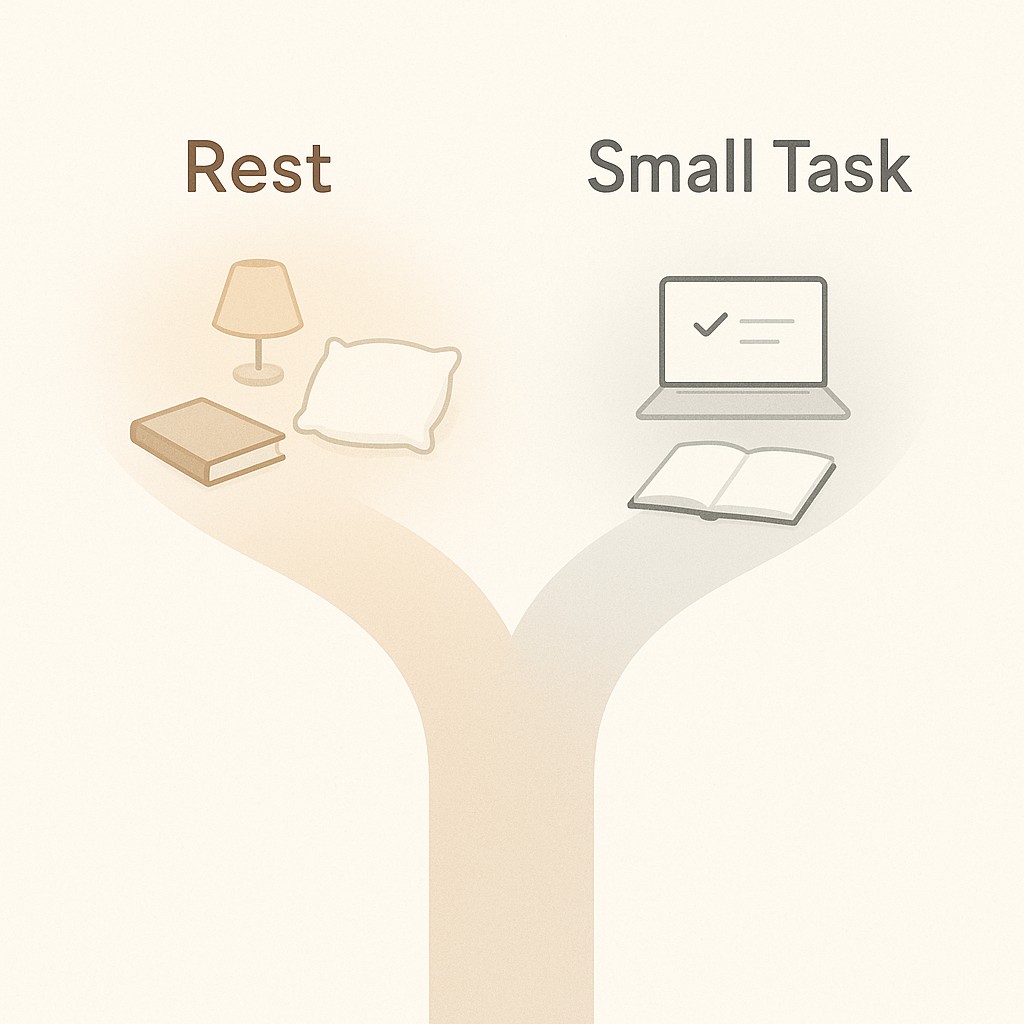Consistency Without Burnout: Show Up Small or Truly Rest
Consistency Without Burnout: Show Up Small or Truly Rest

That One Night I Nearly Didn’t Write
It was late—well past the “I should head home” mark—and I caught myself arriving here later than planned. My friends were still arguing about dessert when it hit me: tomorrow’s post wasn’t written.
I interrupted the table. “Give me a few minutes to write this, or it’ll never get done.” I said it mostly to myself, but I let them hear me. It felt honest, maybe a little sheepish.
Instantly, they pushed back. “Why not make it a show up vs skip call tonight? You’re going through a lot. Take a break.” To be fair, they were right. I’d been stretched thin that week. Back-to-back releases, two team fires to put out, barely a night’s sleep in between. I didn’t exactly look like someone thriving on resolve.
But I had this running internal algorithm. Would the audience or the system even notice if I slipped tonight? Probably not. The numbers would look the same tomorrow.
And yet—the essential decision about consistency without burnout was right in front of me. Would I actually gain a mental reset or just enjoy a moment of laziness?
I can’t help remembering how, a few months back, I let a small deadline slide, told myself it didn’t matter, and then spent the next morning scrambling to patch up the gap. It wasn’t dramatic—just half an hour staring at old notes, realizing I’d let “no big deal” become “I’m behind.” Strangely, that didn’t teach me the lesson all at once. Some nights I still argue with myself. Maybe that’s being human.
Discipline Isn’t Just Grinding—It’s Picking Your Moves
That’s the critical question—discipline vs rest? It circles back every time I hit a wall at midnight. That night at the restaurant, staring at my untouched phone, I knew I had to choose. Force another push, or log off and trust that rest wouldn’t break the streak.
I’ve learned the trick isn’t grand gestures or heroic effort. It’s the smallest viable task (SVT). For an engineer, that might be a ten-minute bug note so you don’t forget tomorrow’s insight. Shipping a tiny pull request to keep the branch alive. Or tossing a comment on a teammate’s code before work piles up. You don’t need to set aside an hour, clear your inbox, or fix every failing test. Just keep the thread alive. If I can show up with a bite-sized effort—a quick experiment, maybe a markdown note for tomorrow’s retrospective—I stay in the loop. It’s not about perfection. It’s about giving your future self something easy to riff on, rather than facing the cold start later.
Momentum and identity get tangled up here. When difficulty feels tied to something important, we start to see time as flexible, making identity-driven progress feel more achievable. The tiny moves matter. Whenever I knock out an SVT, no matter how small, I still feel like the kind of person who shows up. That’s the thread. Over time, these micro-actions reinforce the story—you’re a builder, you’re consistent, you’re not waiting for perfect conditions.
But there’s a fork everyone hits. Sometimes the right move isn’t another task—it’s an actual reset. If sitting down for “just ten minutes” is going to make tomorrow worse, if you’re fried enough that another push feels like punishment, that’s when rest is called for. I’ve mistaken doomscrolling for recovery enough times to spot it now. There’s a difference between mindless delay and genuine restoration, and it’s worth learning to tell them apart. True rest is intentional; avoidance looks like procrastination disguised as self-care.
That night, I chose the quick post because effort was low and momentum mattered for the next day. I got it done. I didn’t overthink the outcome; I just put a pin in the map. That was all I needed, and honestly, it was enough.
The Fast Rule for Consistency Without Burnout: Show Up Small or Truly Rest
Here’s the actual rule I use. It’s just two steps. If you’re genuinely in need of recovery, follow an intentional rest strategy—close the laptop, mute notifications. If not, do the smallest viable task you can knock out in 10 to 15 minutes. That’s it. No second-guessing, no spiraling into a long debate.
The mental checklist is simple: “Do I need full recovery?” If yes, opt out. If no, pick an SVT—one comment, a tiny PR, a stubbed experiment note. The best part is, following a simple if-else rule reliably increases follow-through on intentions, with effects robust across contexts. I literally run this as a quick mental if-else before I open my laptop or thumb the trackpad after midnight. It never takes more than sixty seconds. A quick decision and I’m moving.

To ground it: what does an SVT look like in engineering for developer consistency without burnout? Ten minutes on a bug outline, a micro PR that unblocks tomorrow’s tests, jotting down a tricky failure mode so you actually remember to bring it up at standup. Sometimes it’s flagging a flaky build with a comment, “Spotty since merging X—will verify post-release.” It’s never about heroics. On the flip side, restorative rest means an actual pause. Logging off, maybe stepping away for a walk, or shutting Slack until morning after a week of on-call alerts. Done well, both actions say the same thing. You respect momentum, but you respect sustainability even more.
Honestly, it’s a little like brushing your teeth when you’re too tired to do anything. You don’t skip the routine. You just dial it down—quick pass, no floss, rinse, sleep. It’s not about scrubbing every spot. It’s about keeping the promise to yourself. Procrastination at its finest. But it works.
If you’re on a deadline, supporting users on-call, or staring down a genuine health wall, run the same checklist. Doing the SVT is still right if it’s safe, but true rest and direct communication with your team—letting folks know you’ve hit the wall—protects your integrity. There’s no badge for burning out or surprising your crew. If you ever wonder which way to lean, the rule steers you clearly.
Handling Doubts: Why Small Moves Matter (And When to Stop)
Let’s start with the classic pushback. Can a 10–15 minute task really matter? I get this all the time—from new team members, from folks used to powering through the night, or even from myself on those days it feels pointless. Here’s why it counts. Momentum isn’t some abstract concept; it’s the clear difference between losing your thread and keeping a project alive. If you let a task drop unfinished, your mind keeps looping back to it, primed to resume even after a break. The actual evidence is strong—interrupted tasks get resumed nearly 70% of the time, which is a good reminder that keeping a thread alive matters more than finishing in one go. Streak psychology piggybacks on this.
Tiny, repeated actions stack into a sense of progress and identity. I’ve watched burned-out engineers rediscover their rhythm just by showing up for those micro-moves. Ten minutes on a bug, one commit, a half-written note—none of it feels heroic in the moment, but it brings you back tomorrow ready to work. That’s the point; if you make tiny bets, you keep the cycle going. So don’t throw out the short tasks—they’re how you build the habit that survives bad days.
Of course, small tasks worry people—especially if you care about quality. A mini-PR might clutter the repo; a rushed comment could introduce confusion! Those are valid fears, which is why I use guardrails. SVTs are scoped for non-destructive actions. Tidy, reversible edits, draft notes, sandboxed experiments. As long as you’ve got tests to catch mistakes, a code review stage, and a policy for not merging half-baked changes, these bite-sized moves keep things safe. If you’re debating whether your SVT could mess up the system, scale it back until you’re sure it can’t.
Burnout is the deeper concern—one I wrestle with often. Here’s what’s changed for me: I learned to separate genuine restoration from avoidance. If you feel fried, resentful of your work, or notice your focus slipping for days at a time, that’s not a “show up small” night. You need a deliberate break. Or if the thought of even a ten-minute task fills you with dread, stop and reset. But if you’re just tired, not truly depleted, that’s when SVTs shine; you keep momentum without crossing into self-damage. I’ve had to catch myself, too—walking away and admitting tonight’s not the night. The point is to notice which signal you’re responding to.
If you lead a team, your habits are telegraphed loudly. Modeling intentionality—actually choosing micro-contributions some nights, and showing rest as purposeful—makes discipline visible. You set a norm. We do the work, but we also recognize when to step away. The night I wrote my post at the restaurant wasn’t just about me; it was a signal for everyone who might hesitate tomorrow. Small moves, clear resets—a pattern worth showing.
There’s one thing I haven’t personally nailed, and maybe that’s fine: the exact tipping point between tired and truly exhausted. I can spot it sooner than I used to, but there are still evenings when I’m halfway into an SVT before realizing I should have just gone to bed.
Turning the Rule Into Habit
Start simple. Make two lists. On one side, jot down every smallest viable task—a note you can scribble in ten minutes, a single bug review, leaving one concise comment or prepping a micro-experiment you could hand off tomorrow. Map out what actually fits into that 10–15 minute window. On the other side, capture your rest triggers. What signals tell you it’s time for a real break? Maybe it’s irritability you can’t shake, chronic distraction, or that low-grade headache creeping in after a week of late nights. Seeing both sets laid out makes the choices obvious and shrinks the friction when you’re stretched thin.
Now, install some rituals to maintain habit momentum and make these choices nearly automatic. I started treating my first fifteen minutes each evening as a commit or kill switch. Run the SVT or call rest. No drama, just decide. I keep a checklist visible: “Did I pick an SVT or opt out intentionally?” And at night, I shut down by quickly pre-selecting tomorrow’s SVT, so I know exactly where to start next time. Turns out, these tiny temporal anchors help habits stick; just naming and repeating the moments wires in the behavior.
When the smallest viable task is enough, let AI draft your post, commit notes, or brief summary in minutes, so you keep momentum and reserve real rest for tomorrow.
Thinking back to that night at the restaurant—the moment I nearly skipped—the tiniest post was enough to keep the streak alive. In practice, small absolutely can be sufficient, because it’s the consistency that shapes your identity as much as the output itself.
Here’s your guiding question: when do you push through, and when do you reset? Decide with intention today. Every choice builds the story of who you are, one deliberate, actionable moment at a time.
Enjoyed this post? For more insights on engineering leadership, mindful productivity, and navigating the modern workday, follow me on LinkedIn to stay inspired and join the conversation.
You can also view and comment on the original post here .
